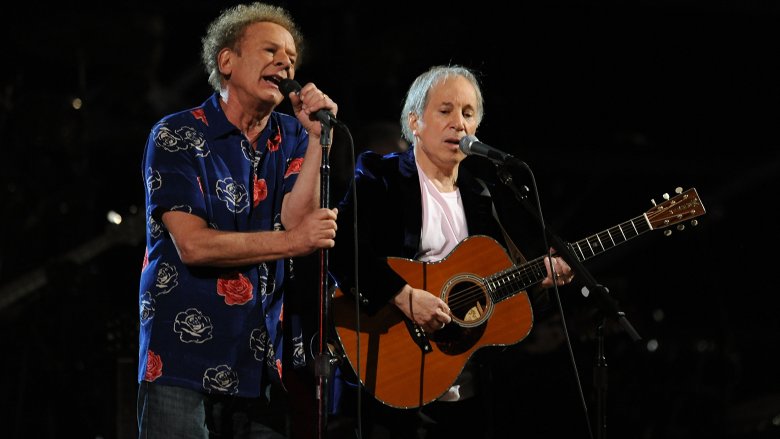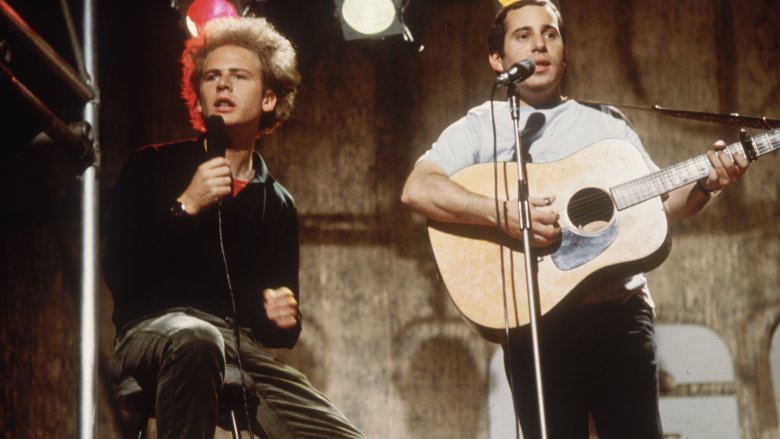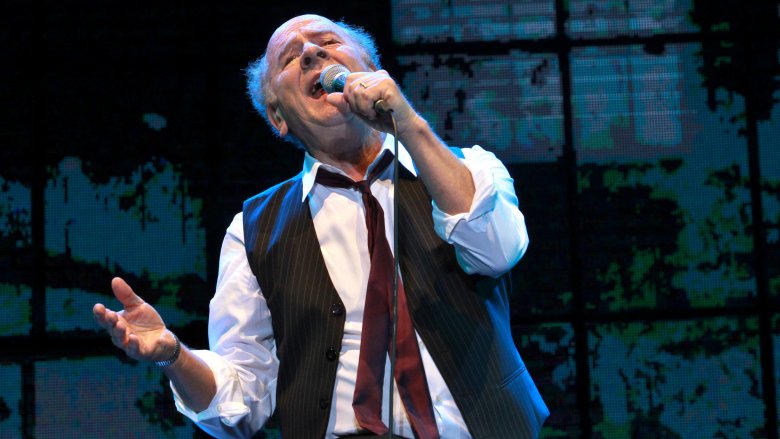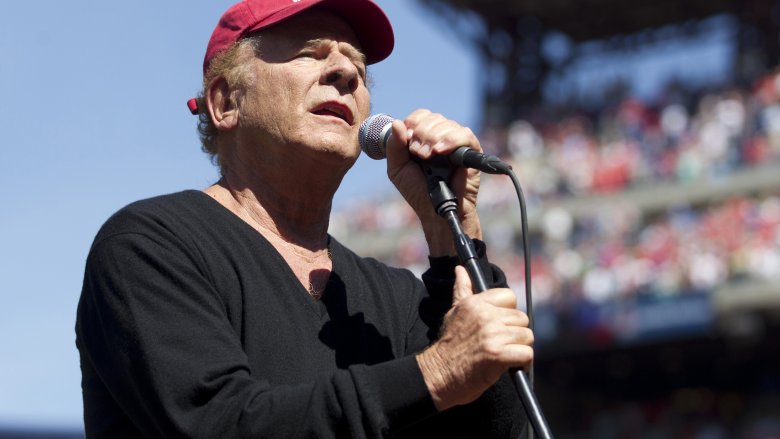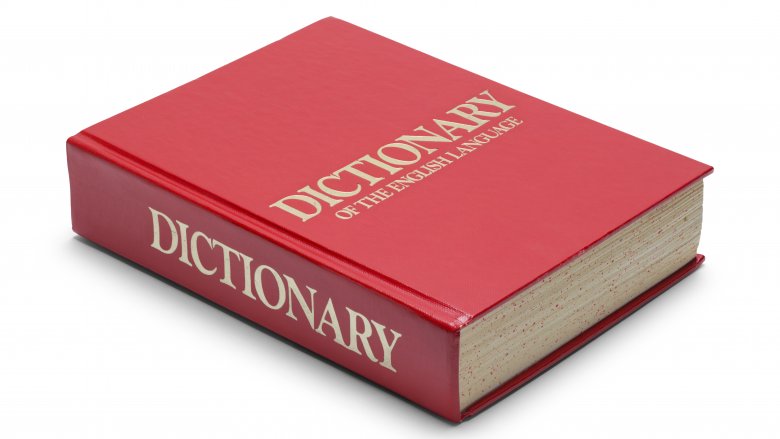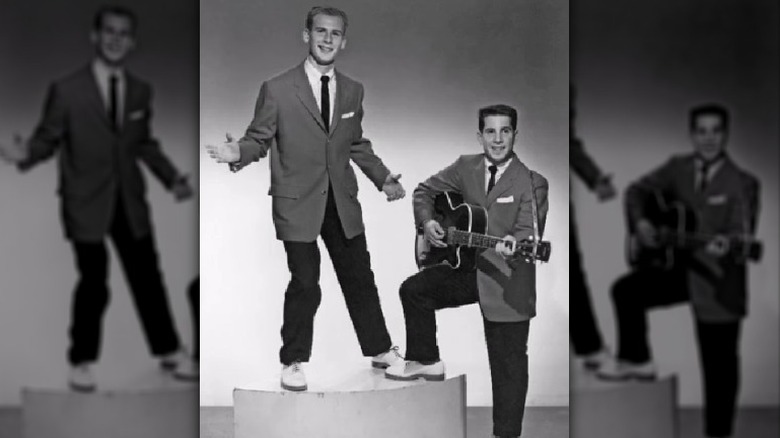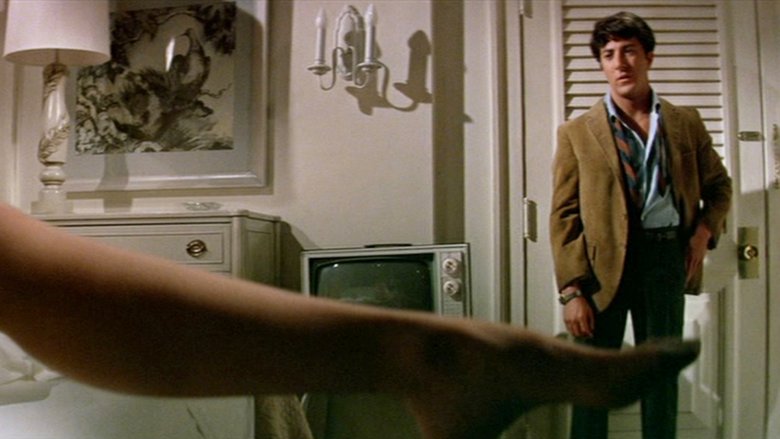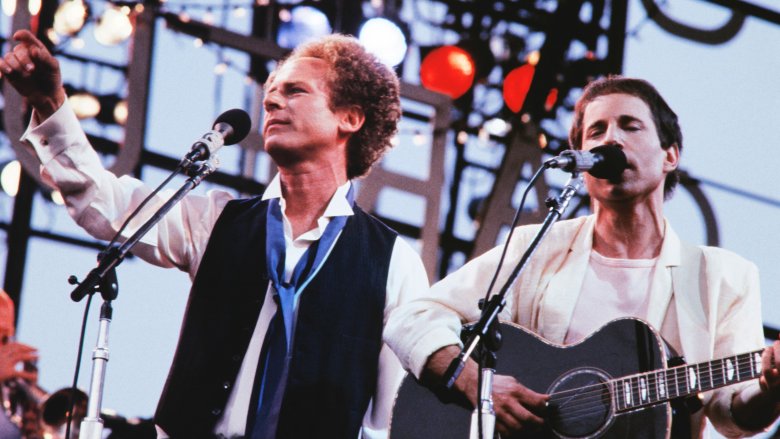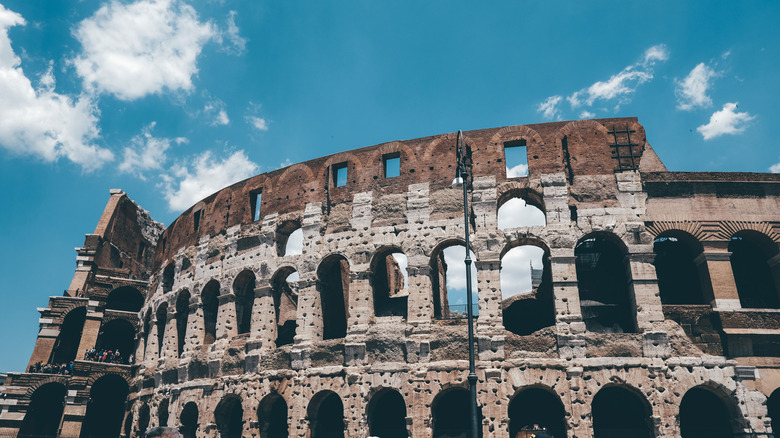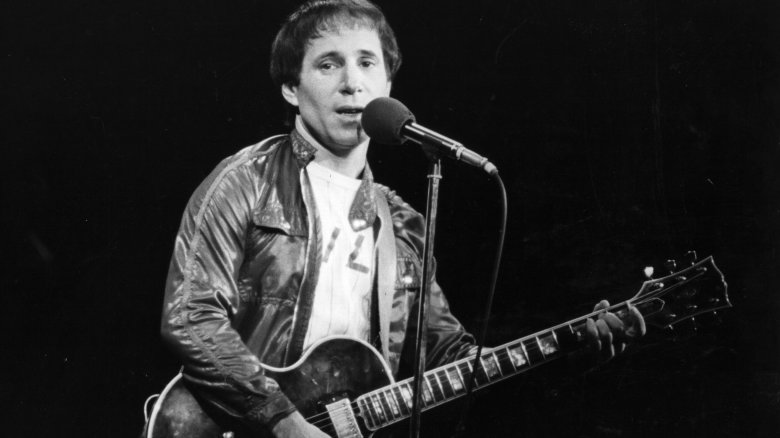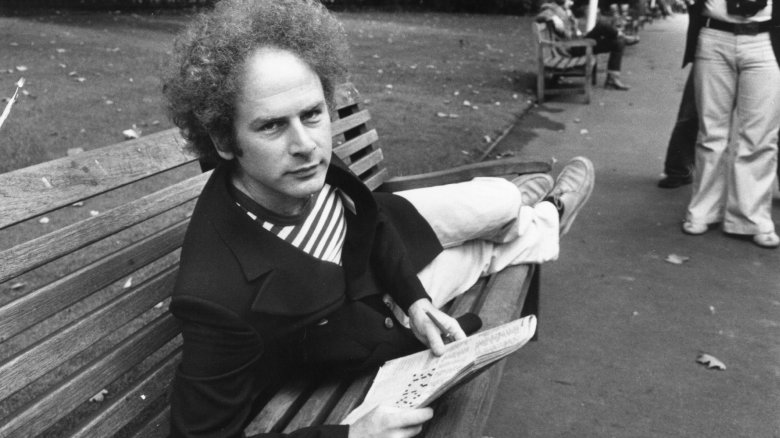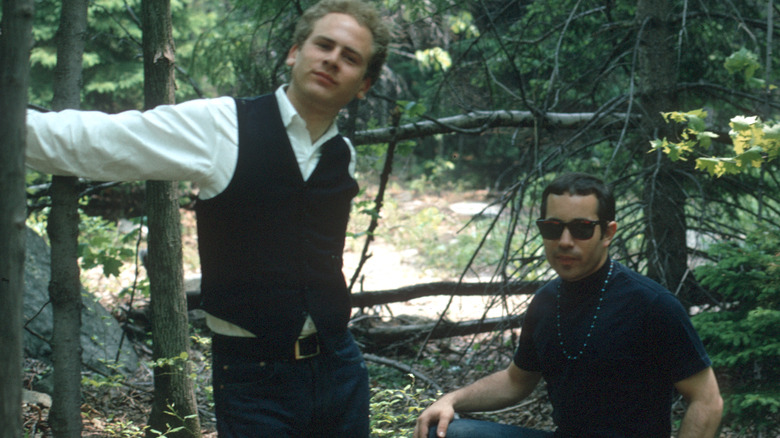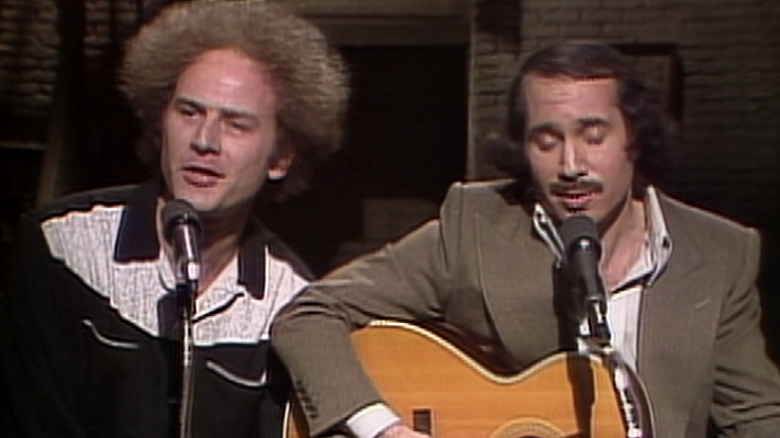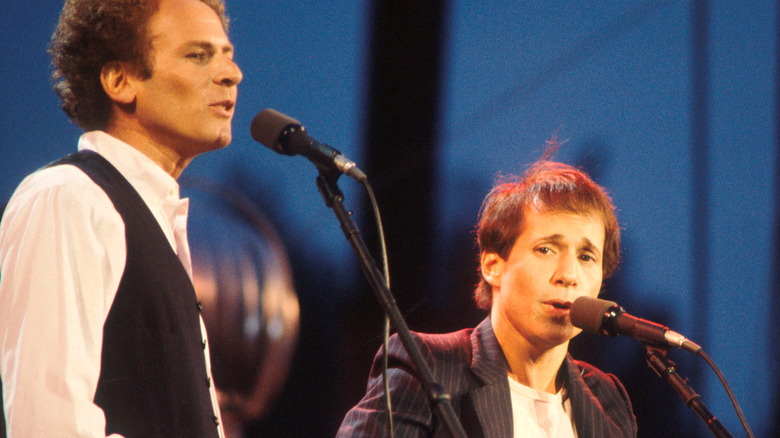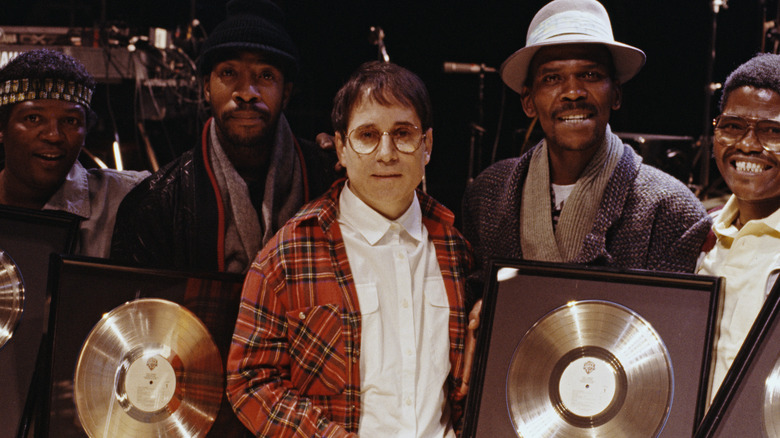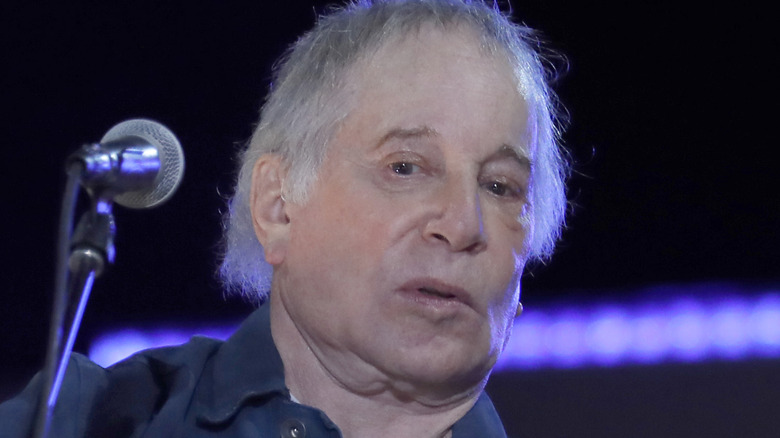The Untold Truth Of Simon And Garfunkel
They never really looked like rock stars, but Paul Simon and Art Garfunkel are certified music legends, helping to popularize folk rock and enriching millions with their iconic harmonies. But if all you know about the duo is their music and that Simon is shockingly short for a rock 'n' roll guy, you've got a lot to learn. Here are some fascinating tidbits about the pair, both together and apart.
They didn't intend to become folk rock
Thanks to the success of rock standards like "The Sound of Silence," Simon and Garfunkel will forever be credited with inventing folk rock, or at least helping to make it as popular as it was in the '60s and '70s. But if the pair had their way, it never would've happened.
As AllMusic explains, when Paul Simon and Art Garfunkel recorded "Silence," it was just like the rest of their 1964 debut album, "Wednesday Morning, 3 A.M.": entirely acoustic. For the most part, the album was just acoustic guitars and the duo's vocals, which struck a chord with basically nobody. The album initially flopped, prompting the pair to briefly split up. Then, in 1965, producer Tom Wilson noticed some radio stations were beginning to pay attention to "Silence," and he immediately took advantage. Without telling either Simon or Garfunkel, he remixed the song by adding electric guitars, electric bass, and drums, turning it into the version most people (unless they're Disturbed or Nevermore fans) think of today.
The "Silence" rock remix proved super-successful, prompting the duo to reunite and record a new album, which officially launched their careers as music megastars. And this is why producers exist.
Art Garfunkel lost his voice for four years
Art Garfunkel didn't write many S&G songs, but he earned his keep with his incredible, hauntingly angelic voice. "Bridge Over Troubled Water" simply wouldn't have been the same had Simon sang lead. Sadly, for years that voice was gone, and it seemed like it was never coming back.
As Garfunkel recapped in a 2014 Rolling Stone interview, starting in early 2010, his voice began to fade after he ate lobster and choked on a big piece. Days later, he started having trouble swallowing, and a doctor visit revealed one of his vocal cords was "stiffer and fatter than the other one." This meant, in short, he couldn't sing. He could still hit high and low notes, but couldn't go mid-level, making him — in his words — "crude instead of fine." After all, people listen to "Bridge" for the whole thing, not just "I will ease your MIIIIIIIINNNNNDDDD."
Onstage with Paul Simon during the New Orleans Jazz and Heritage Festival, Garfunkel could barely sing a note. Shortly thereafter, the pair's tour was postponed, then canceled. In 2011, Garfunkel began retraining his voice at a rented concert hall, putting on "real show[s] without the people." The following year, he began performing super-tiny, private shows at a New York art gallery, basically rehearsing in front of 90 or fewer people, still fighting to get the kinks out of his timeless voice. As he grew stronger and more confident, he would play increasingly bigger shows until, after four years of fighting, he could finally sing all his songs, including "Bridge," once again. Avoid the lobster, man.
Art Garfunkel is a walking machine
It's great to exercise and move, but Art Garfunkel takes it to a whole other level. The man, to put it mildly, walks literally everywhere, and the longer the distance the better.
According to his website, he first began long-distance walking in the early '80s, when he was touring Japan and decided it'd be a great idea to walk from one end of it to the other. He enjoyed that excursion so much, he soon set his sights on a way bigger country: the United States. In 1983, he began his "Walk Across America," where he literally walked from one end of the U.S. to the other. He didn't do it in one go, which would've taken him roughly six months, but rather in various chunks (averaging about three treks a year) over a 14-year span. In 1997, he finally reached his goal: South Jetty, Oregon, on the edge of the Pacific. Why do something so objectively insane? Clearly, taking the long way is in his blood.
Garfunkel celebrated his gigantic walk by almost immediately starting up another gigantic walk. In 1994, he began walking across Europe, planning to stroll from Ireland to Istanbul. In 2014, he finally completed his venture, and immediately followed it up with a concert tour because the man can't stop, won't stop. Next walk: to the Moon, probably.
Art Garfunkel lists every book he's read (including the dictionary) on his website
Art Garfunkel really loves to read, and also loves to tell you how much he loves it. So though it's highly likely no one asked, Garfunkel's website contains a list of every single book he's read over the past 50 years or so.
He doesn't review the books, or talk about them in any way. He just lists the title, author, year of publication, month and year he read it, and the page count. Did you know he read John Reed's "Ten Days That Shook The World" in December 1979? You do now! You still don't know if he liked it, or if it spoke to him in any way, but he sure spent part of that month poring through it. He does offer a separate page listing his favorite books ever, but even then it's just a list of books he really enjoyed.
Perhaps the most curious entry in his list comes from March 1993, when he read the dictionary. That's no joke: he literally read all 1,664 pages of the Random House dictionary, which is technically like reading every book ever written, just all scrambled up. Still though, why not just read an actual book? He seems to be pretty good at that. In fact, as of 2021, he's read 1,310 books. He hasn't posted any new books since then. Perhaps his eyes are simply getting old, or perhaps he started "A Song of Ice and Fire" and can't make heads or tails of it.
They started as a pop duo called 'Tom and Jerry'
It's hard to imagine Simon or Garfunkel feeling they had to hide behind pseudonyms once, but that's exactly how they started their careers. Paul Simon, in particular, went through several fake names before finally settling on his real name as his favorite.
When the pair started writing and playing together, they weren't crafting folk songs, but rather '50s sock-hop teen pop. Emulating their idols, the Everly Brothers, Simon and Garfunkel would perform corny bubblegum songs like "Hey Schoolgirl," their first hit. "Schoolgirl" scored them a record deal, but not as Simon and Garfunkel. According to Rolling Stone, the label feared their actual names were "too ethnic" and would alienate the Middle America crowd. (It was a different time.) So Art Garfunkel became Tom Graph and Paul Simon became Jerry Landis, or "Tom and Jerry." Sadly, Garfunkel didn't chase Simon around the house only to take a mousetrap to the tail.
Simon quickly decided he liked hiding his cheesy, unsophisticated music behind a pretend name, and crafted several more over his pre-S&G career. Variously, he was Jerry Landis, True Taylor, and Paul Kane. He also joined various bands (The Mystics, Tico and the Triumphs), usually under the Jerry Landis name. Garfunkel, meanwhile, was Tom until the pair got good enough that he could stop being Tom. Too bad they didn't record a song or two as "Bugs and Daffy," just for the laughs.
'Mrs. Robinson' was almost 'Mrs. Roosevelt'
"Mrs. Robinson" is one of the most famous movie songs ever, though it wasn't originally conceived that way. Originally it was just another song, and the title character had a very different name.
Tony Dunsbee's book, "Gathered From Coincidence," quotes Art Garfunkel's explanation. He and Paul Simon were approached by CBS's Mike Nichols to contribute songs to "The Graduate" — one wound up being "Mrs. Robinson." But at the time, according to Garfunkel, they hadn't settled on a name: "any three-syllable name" worked as a placeholder. Mostly, she was "Mrs. Roosevelt," though once the movie became a thing, they'd occasionally sing "Mrs. Robinson." Somehow, neither Simon nor Garfunkel concluded, "you know what, that's the name." It took Nichols to do that.
During a meeting with the group, Nichols asked if they had any other songs for the film. Garfunkel suggested "Mrs. Robinson," and Nichols immediately snapped to attention. He asked the world's most obvious question: "you have a song called 'Mrs. Robinson' and you haven't even shown it to me?" Garfunkel replied, according to Bill Flanagan's book, "Written in My Soul," "Well, I don't know if it's 'Mrs. Robinson' or 'Mrs. Roosevelt,'" because you can lead Garfunkel to answers, but you can't make him think. Nichols responded, "Don't be ridiculous! We're making a movie here! It's 'Mrs. Robinson'!" Somehow, he managed to not end that line with "duuuuuhhhhhhh." But the duo got the point, and the song permanently became about Mrs. Robinson. And Joe DiMaggio, for some reason.
Their '80s reunion album became a Paul Simon solo album (that flopped)
The '80s almost saw a Simon and Garfunkel reunion that extended beyond the stage and into the studio. We would finally get a new S&G album, and the world was stoked. Then, nothing happened, and the world was less stoked.
According to Ultimate Classic Rock, after the pair successfully reunited in 1981, their attention turned to crafting their first new album since 1970, called "Think Too Much." But sadly for those who thought too much about the album, it never happened, thanks to mean old Mr. Creative Differences. As Paul Simon explained in a 1984 Playboy interview, "I wanted to be there when [Garfunkel's vocal sessions] happened because I knew that if what he did wasn't all right with me, I wasn't going to let it go." Garfunkel wanted to sing alone, and wasn't at all happy when Simon refused his request.
Rhymin' Simon's attempts to assert himself as the group's boss prompted Art Garfunkel to quit, leaving Simon with a bunch of songs and no album. He recorded them anyway, releasing them in 1983 as "Heart and Bones," his latest solo effort. But being promised a Simon and Garfunkel reunion and just getting Simon is like surf-and-turf without the steak, and the album flopped commercially. It's since gained a reputation as one of his better, more mature albums, but that still doesn't change how we lost out on new Simon and Garfunkel because Simon wouldn't leave Garfunkel alone for even a day.
They played outside the Roman Colosseum for 600,000 people
It's awesome enough to perform in Rome. It gets cooler when you perform at the Roman Colosseum. To have 600,000 fans watch you do it, as Simon and Garfunkel experienced in 2004, must be downright surreal.
During one of their many brief reunion shows, Simon and Garfunkel hit Rome to perform. According to Yahoo Music, their music regularly gets translated into Italian and performed by local bands, so they had more than a small following. Also, the pair didn't just play some modern arena: they played the actual Roman Colosseum. Kind of. They didn't actually perform inside the Colosseum, since it's super-ancient and the inside is basically ruins. Also, you couldn't fit more than 50,000 people in there on its best day, and far more folks were interested in a S&G reunion than that. So instead, they set up a stage just outside the Colosseum and, like the world's most successful buskers, played on the streets for their adoring fans.
All in all, over 600,000 fans showed up to partake, and only partially because the show was free. They legitimately loved the band and wanted to be there to see them play, even if it meant dealing with a Colosseum crowd that dwarfed even the busiest tourist season.
Paul Simon was briefly on a United Nations boycott list
Paul Simon's never been the most outrageous or controversial of musicians, and yet he still managed to get the United Nations peeved at him, simply for performing.
According to the New York Times, in 1987 Simon found himself on the U.N.'s boycott list. Apparently, they were angry that, in 1985, Simon had recorded some songs for his "Graceland" album in South Africa. In 1980, the U.N. officially began a "cultural boycott" of the nation because it embraced apartheid and the U.N. wasn't too cool with that. So when Simon hit South Africa to create his album, the U.N. saw that as him breaking the boycott, putting him on their no-no list.
Being on the U.N. no-no list is bad publicity, so Simon worked fast to put a stop to it. Despite feeling he didn't break the U.N. boycott since he only recorded in South Africa and didn't perform, he wrote the group a letter, promising he wouldn't actually perform in South Africa. That was apparently enough for the U.N., which promptly removed him from its list and officially made it okay to enjoy "Still Crazy After All These Years" without implicitly thumbing your nose at the entire global assembly.
Art Garfunkel taught geometry for nine months in 1971
When Simon and Garfunkel separated in 1970, Paul Simon predictably launched a super-successful solo career. Art Garfunkel, meanwhile, defied all expectations and became a math teacher, which is exactly what you do when you have one of the sweetest golden throats in music history.
During an interview with The Guardian, the academically inclined Garfunkel (who had gone back to school when he and Simon first split in 1964) elaborated on his abrupt career change. In 1971, he took a gig teaching geometry at a Connecticut private school, which had to have been quite the first-day perk for any student of his. But Artie immediately cut the "my teacher's famous" thing off at the knees, telling the kids, "Yeah, I've had 'Bridge Over Troubled Water,' but we're not going to talk about that, we're going to talk about geometry, and at the end of the year I'll deal with the fame trip." According to him, it worked, as the kids seemed pleasantly shocked he was taking the job seriously, and not just doing research for a new song called "Parsley, Sage, Rosemary, and Cosine."
The gig didn't last long, as Garfunkel was back on the road touring within nine months. Perhaps he just needed some time to clear his head post-breakup and chose to do it around a blackboard. Whatever the reason, he clearly has a lucrative career in academia waiting for him if he so desires. But he'll likely just choose to walk somewhere really far away instead.
Simon and Garfunkel fought hard to make 'The Boxer'
"The Boxer" is a landmark song, though its story's seldom told. Released almost a year before its inclusion on the Simon and Garfunkel album "Bridge Over Troubled Water," "The Boxer," a stark, dramatic folk rock epic of a song, peaked at No. 7 on the Billboard Hot 100 in 1969.
On the surface, the song tells the cinematic tale of a boxer, knocked around and beaten up by both his in-ring exploits and the unsettled life his choice of profession brings. It's really about something else: being a critically derided rich and famous musician. "I think the song was about me: everybody's beating me up," Simon told Playboy in 1984. "By that time we had encountered our first criticism," that they weren't true folkies from the Greenwich Village folk rock tradition but rather opportunistic ringers exploiting the then-popular form.
Indeed, "The Boxer" is hardly gritty or lo-fi. According to the Financial Times, it took more than 100 hours to perfect, utilizing a wide array of hired session musicians and recording spots, including a studio in Nashville, St. Paul's Chapel on the campus of Columbia University in New York City, and an elevator shaft at Columbia Records' studio facilities across town.
Live from New York, it's Simon and Garfunkel
According to Biography, Simon and Garfunkel quietly broke up in 1970, but they wouldn't be apart for long. In the '70s, both performers pursued solo endeavors that proved successful — Art Garfunkel acted in movies like "Catch-22" and "Carnal Knowledge," and Paul Simon became a pop-rock superstar with smash hits like "Kodachrome" and "50 Ways to Leave Your Lover." According to Robert Hilburn's "Paul Simon: The Life," Simon became fast friends in 1975 with Lorne Michaels, when preproduction was underway for the show that would become "Saturday Night Live." When that show debuted later that year and quickly became a cultural phenomenon, Simon served as guest host on the second-ever episode, according to Vulture, which counted Garfunkel among its multiple musical guests. While Simon performed his then new single "Still Crazy After All These Years," he later hit the stage to reunite with Garfunkel to sing "The Boxer" and "Scarborough Fair."
Simon would eventually appear on "SNL" as a host three more times and as a musical guest nine times, while Garfunkel would preside over a single episode in 1978, as per Entertainment Weekly. However, when Simon closed out his career with a final TV performance on "SNL" in 2018, he did so by singing "Bridge Over Troubled Water," the signature song of Simon and Garfunkel, and one on which Garfunkel had usually handled lead vocals.
Their 1981 concert in Central Park was an epic event
In addition to their brief reteaming on "Saturday Night Live" in 1975, Simon and Garfunkel recorded "My Little Town" that year, a top 10 hit. Art Garfunkel then cameoed on "The Paul Simon Special" (via Art Garfunkel's website), they teamed up to cover Sam Cooke's "(What a) Wonderful World," and played a 1978 benefit concert. The stage was set for a big reunion blowout.
By the early 1980s, Central Park, the iconic urban green-space and gathering area of Simon and Garfunkel's New York City hometown, was in a state of disrepair, as the greatly cash-strapped municipal government struggled to provide the financial resources needed for upkeep and restoration. NYC Parks Commissioner Gordon Davis, per Gothamist, struck on the idea of raising awareness for the cause of saving Central Park by using the area to stage a free outdoor concert, with proceeds generated by ancillary materials, according to Far Out.
Promoter Ron Delsener (per Robert Hilburn's "Paul Simon: The Life") pitched Simon on a Simon and Garfunkel concert in Central Park, but he passed, on account of how he didn't think a sizable audience would come (his 1980 movie "One-Trick Pony" had flopped). But he floated the idea to Garfunkel anyway, who loved the idea and quickly flew to the U.S. from his home in Switzerland to plan and perform. Simon and Garfunkel took the stage in September 1981, and Simon's fears were unfounded — as many as 500,000 people came to watch the duo play its old hits, according to the New York Daily News.
When Paul Simon went to 'Graceland'
"Graceland" is one of the most lauded work of Paul Simon's career. Released in 1986, it spent nearly two years on the Billboard album chart, sold five million copies, and won the Grammy Award for Album of the Year. "Graceland" was a creative departure for Simon and unlike anything else in mainstream American music in the mid-1980s, incorporating traditional and modern African music forms. According to Rolling Stone, he got the idea from Heidi Berg, former bandleader on the canceled NBC sketch comedy series "The New Show." It was produced by "SNL" creator Lorne Michaels, who connected Berg with his close friend, Simon, as both were in need of a new musical project. They talked about making an album, and Berg gave Simon a bootleg compilation of mbaqanga, street pop from the South African town of Soweto. Simon religiously listened to the tape for weeks and got the idea to buy the rights to a particular instrumental track and put his own original lyrics and melody over it. South Africa-based producer Hilton Rosenthal told Simon it would probably be much more fruitful to just make an entirely new album of South African-inspired songs.
Meanwhile, Simon ghosted Berg. When they bumped into each other backstage at one of his concerts, Simon told Berg about his plans for the South African record. She asked for a financial cut, didn't get one, and they never made that album.
Paul Simon pretty much retired in 2018
In 2016, Paul Simon released his 13th studio album, "Stranger to Stranger," which peaked at a respectable No. 3 on Billboard's album chart. Approaching 80 years old, Simon thought that this record would be a good one to go out on, and with the release of "Stranger to Stranger," he announced his retirement from the two major pillars of being a major musical star, recording albums and touring. "I've often wondered what it would feel like to reach the point where I'd consider bringing my performing career to a natural end. Now I know: it feels a little unsettling, a touch exhilarating, and something of a relief," Simon said in a letter he posted to Twitter in February 2018, adding that his decisions was exacerbated by the 2017 death of Vincent N'guini, his friend and guitarist for three decades.
In 2018, Simon embarked on "Homeward Bound," a farewell tour, ending with a show at Flushing Meadows Corona Park, outside his hometown of New York City, per NME, and released the remix album "In the Blue Light." And then, he was done, although he said he'd occasionally play one-off charity concerts, should the mood strike. He then hammered home the idea that he was really done by selling his song catalog to Sony Music Publishing for an unrevealed but presumably huge amount of money, according to The Guardian.
